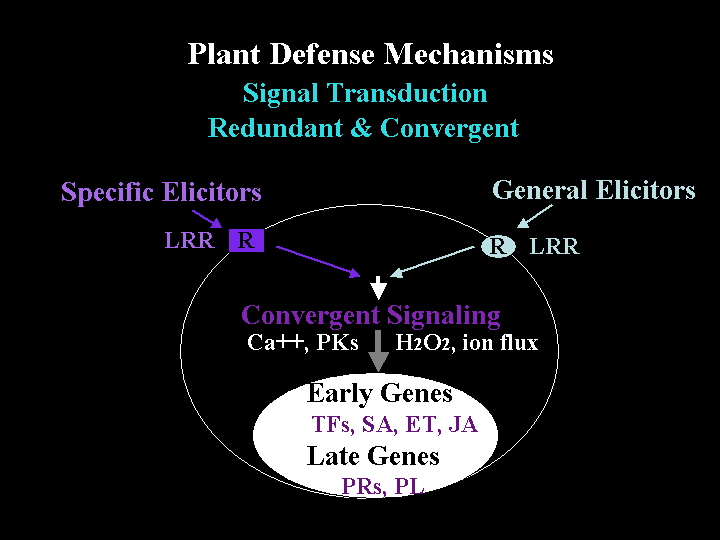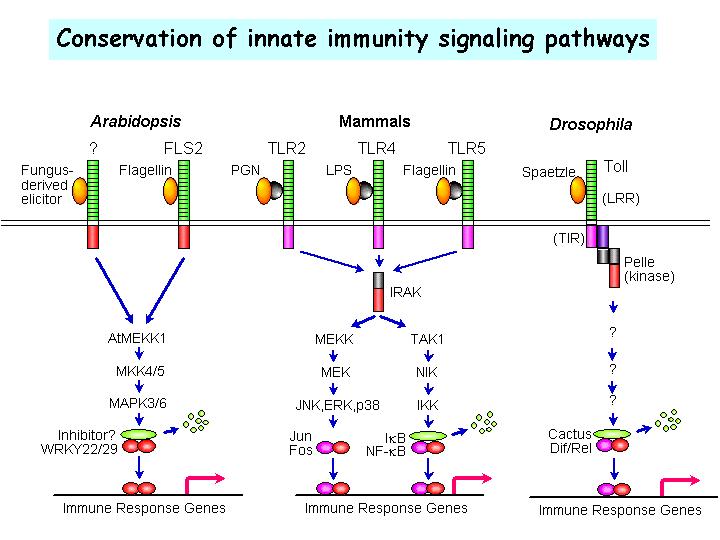| |
| Research
| INNATE
IMMUNITY
  Supported
by the NSF DBI Program and the NIH Supported
by the NSF DBI Program and the NIH
Summary |
| 
|
There is remarkable
conservation in the recognition of pathogen-associated
molecular patterns (PAMPs) by innate immune responses
of plants, insects and mammals. We developed an Arabidopsis
thaliana leaf cell system based on the induction of
early-defence gene transcription by flagellin, a highly
conserved component of bacterial fagella that functions
as a PAMP in plants and mammals. |
| |
| 
|
Here we identify a complete
plant MAP kinase cascade (MEKK1, MKK4/MKK5 and MPK3/MPK6)
and WRKY22/ WRKY29 transcription factors that function
downstream of the flagellin receptor FLS2, a leucine-rich-repeat
(LRR) receptor kinase. Activation of this MAPK cascade
confers resistance to both bacterial and fungal pathogens,
suggesting that signalling events initiated by diverse
pathogens converge into a conserved MAPK cascade. |
|
Signaling
Pathway Illustrations
Click to show details
|
| Education
powerpoint presentation
Plant signalling
A MAPK cascade in Arabidopsis
innate immunity
|
| Review
Boudsocq, M. and Sheen, J. 2010.
Calcium Sensing and Signaling. In: Abiotic Stress Adaptation in Plants: Physiological, Molecular and Genomic Foundation (A.Pareek, S.K. Sopory, H.J. Bohnert, Govindjee, eds). Springer, Dordrecht, The Netherlands: Springer, pp.75-90 PDF
Sheen, J., He, P., Shan, L., Xiong, Y., Tena, G., Yoo, S., Cho, Y., Boudsocq, M.,and Lee, H. 2008.
Signaling specificity and complexity of MAPK cascades in plant innate immunity. Biology of Molecular Plant-Microbe Interactions. Chapter 86. PDF
Shan, L., He, P., and Sheen, J. 2007. Intercepting Host MAPK Signaling Cascades by Bacterial Type III Effectors.
Cell Host & Microbe 1:167-174 PDF
He, P., Shan, L., and Sheen, J. 2007. Elicitation and Suppression of Microbe-Associated Molecular Pattern-Triggered Immunity in Plant-Microbe Interactions.
Cellular Microbiology 9:1385-1396 PDF
Sheen, J. and He, P. 2007. Nuclear Actions in Innate Immune Signaling.
Cell 128:821-822 PDF
Shan, L., He, P., and Sheen, J. 2007. Endless Hide-and-Seek:
Dynamic Co-evolution in Plant-Bacterium Warfare. J.Integr. Plant Biol.
49(1):105-111 PDF
Hamel, L.-P., Nicole, M.-C., Sritubtim, S.,
Morency, M.-J., Ellis, M., Ehlting, J.,
Beaudoin, N., Barbazuk, B., Klessig, D., Lee, J.
Martin, G., Mundy, J., Ohashi, Y., Scheel, D., Sheen, J.,
Xing, T., Zhang, S., Seguin, A. and Ellis, B.E. 2006. Ancient signals:
comparative genomics of plant MAPK and MAPKK gene families : Trends in Plant Science
11(4): 192-198 PDF
He, P., Shan, L., and Sheen, J. 2006. The Use of Protoplasts to Study Innate Immune Responses.
Plant-Pathogen Interactions Volume 354: pps. 1-10 PDF
Sheen, J. 2001. Signal transduction in maize and Arabidopsis
mesophyll protoplasts. Plant Physiol. 2001 Dec;127:1466-1475
PDF
Tena,
G., Asai, T., Chiu, W.-L., and Sheen, J. 2001. Plant mitogen-activated
protein kinase signaling cascades. Curr. Opin. Plant Biol.
4:392-400 PDF
back to top
|
| Articles
Lee, H., Chah, O.K., and Sheen, J. 2011.
Stem-cell-immunity through CLV3p-FLS2 signalling. Nature 473:376-379 PDF SUPP
Boudsocq, M., Willman, M., McCormack, M., Lee, H., Shan, L., He., P., Bush, J., Cheng, S.H., and Sheen, J. 2010.
Differential innate immune signalling via Ca2+ sensor protein kinases. Nature 464:418-423 PDF SUPP
Fujii, H., Chinnusamy, V., Rodrigues, A., Rubio, S., Antoni, R., Park, S.-Y., Cutler, S.R., Sheen, J., Rodriguez, P.L. andZhu, J.-K. 2009.
In vitro reconstitution of an abscisic acid signaling pathway. Nature. 462: 660-664. PDF SUPP
Shan, L., He, P., Li, J., Heese, A., Peck, S.C., Nürnberger, T., Martin, G.B. and Sheen, J. 2008.
Bacterial Effectors Target the Common Signaling Partner BAK1 to Disrupt Multiple MAMP Receptor Signaling Complexes and Impede Plant Immunity. Cell Host & Microbe 4: 17-27 PDF SUPP
Yoo, S-D., Cho Y-H., Tena G., Xiong. Y. and Sheen, J. 2008.
Dual control of nuclear EIN3 by bifurcate MAPK cascades in C2H4 signalling.
Nature 451: 789-795 PDF SUPP
Chen, Z., Agnew, J.L., Cohen, J.D., He, P., Shan, L., Sheen, J. and Kunkel, B.N. 2007.
Pseudomonas syringae type III effector AvrRpt2 alters Arabidopsis thaliana auxin physiology.
PNAS 104: 20131-20136 PDF
Xiao,F., He, P., Abramovitch, R.B., Dawson, J.E., Nicholson, L.K., Sheen, J.
and Martin, G.B. 2007.
The N-terminal region of Pseudomonas type III effector AvrPtoB elicits Pto-dependent immunity and has two distinct virulence determinants.
The Plant Journal 52: 595-614 PDF
He, P., Shan, L., Lin, N.-C., Martin, G.B.,
Kemmerling, B., Nurnberger, T., and Sheen, J. 2006.
Specific Bacterial Suppressors of MAMP Signaling Upstream
of MAPKKK in Arabidopsis Innate
Immunity. Cell125: 563-575 PDF SUPP.
Asai,
T., Tena, G., Plonikova, J., Willmann, M., Chiu, W.-L.,
Gomez-Gomez, L., Boller, T., Ausubel, F.M., and Sheen, J.
2002. MAP kinase signaling cascade in Arabidopsis innate immunity.
Nature 415:977-983 PDF
Asai, T., Stone, J. M., Head, J.E., Kovtun, Y., Yorgey, P.,
Sheen, J.,and Ausubel, F.M. 2000. Fumonisin B1-induced cell death
in Arabidopsis protoplasts requires jasmonate-, ethylene-,
and salicylate-dependent signaling pathways. Plant Cell 12:
1823-1835.
Kovtun,
Y., Chiu, W.-L. Tena, G., and Sheen, J. 2000 Functional
analysis of oxidative stress-activated MAPK cascade in plants.
PNAS. 97:2940-2945
|
|
|